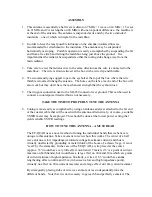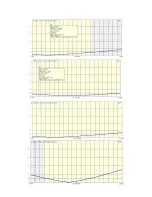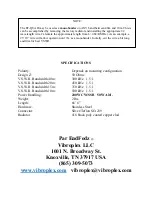
ASSEMBLY
1.
This antenna is essentially a half wave radiator on 7 MHz / 1 wave on 14 MHz / 1.5 wave
on 21 MHz and 2 wavelengths on 28 MHz with one important difference– the feedline is
at the end of the antenna. The antenna is suspended at its ends by the two included
insulators – one of which is integral to the matchbox.
2.
In order to have the least possible influence on the antenna, insulated lines are
recommended for attachment to the insulators. The antenna may be suspended
horizontally or sloping. Portable operation is easily accomplished by suspending the far
end from a tree limb and letting the matchbox hang just above the ground. It is
important that the radiator be suspended so that the tuning stubs hang away from the
main radiator.
3.
Take care to erect the radiator wire in the same direction as the wire is connected to the
matchbox. The wire is strain relieved at the box with a wire clip and thimble.
4.
We recommend tying support rope to the eyebolt at the top of the box where the wire
thimble is located to hang the antenna. The holes on the tabs at each end of the box will
also work but they don’t have the mechanical strength that the eyebolt does.
5.
The wingnut connection next to the SO-239 connector is at ground. This can be used to
connect a counterpoise if desired but is not necessary.
TAKE THE TIME TO PROPERLY TUNE THE ANTENNA
6.
Tuning is most easily accomplished by using an antenna analyzer attached to the far end
of the coaxial cable that will be used with the antenna. Alternatively, of course, a suitable
VSWR meter may be employed. This should be done at the lowest power setting that
yields reliable VSWR readings.
HOW TO TUNE THIS ANTENNA– A MUST READ
The EF-QUAD uses a novel method of tuning the individual bands that we believe is
unique to this antenna. Take a moment to review how this works. The center of a half
wave antenna is low impedance (minimum voltage/maximum current) and thus is
virtually unaffected by grounding or metal (think of the boom of a classic Yagi– it is not
“seen” by the elements). In the case of the EF-QUAD, a wire placed at the center
(approx. 33’) would have very little effect on 40 and 15 meters (33’ is a point of current
maxima on both bands), but would have a large effect on 20m and 10m which are points
of current minima or high impedance. Similarly, a wire at 16.5’ would have
some
lengthening effect on 40m and 15m (in between a low and high impedance point),
virtually no effect on 20m (current maxima) and a large effect on 10m (current minima)
By strategically placing stubs of wire we can more or less independently tune the
different bands. Note that it is not necessary to get each band perfectly centered. The
Summary of Contents for ENDFEDZ EF-QUAD
Page 4: ......























